





 ISIT2011 TPC Chairs Contact E-Mail: isit2011@eng.tau.ac.il
Local Tours
ISIT2011 TPC Chairs Contact E-Mail: isit2011@eng.tau.ac.il
Local ToursSt Petersburg City Tour (base)
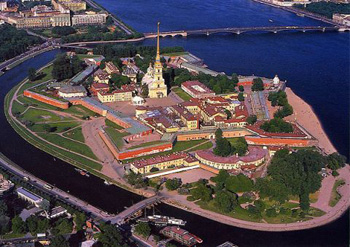 Saint Petersburg is a city and a federal subject (a federal city) of Russia located on the Neva river at the head of the Gulf of Finland on the Baltis Sea. In 1914 the name of city was changed to Petrograd, in 1924 to Leningrad and in 1991 back to Saint Petersburg.
Saint Petersburg is a city and a federal subject (a federal city) of Russia located on the Neva river at the head of the Gulf of Finland on the Baltis Sea. In 1914 the name of city was changed to Petrograd, in 1924 to Leningrad and in 1991 back to Saint Petersburg.
In Russian literature and informal documents the "Saint" is usually omitted, leaving Petersburg. In common parlance Russians may elide "-burg" as well, leaving only Peter,also uses a short writing "Spb".
Saint Petersburg was founded by Tsar Peter I of Russia on 27 May 1703. From 1713 through 1728 and from 1732 it was the capital of the country until 1918 when the central government bodies finally moved from Petrograd to Moscow. It is Russia's second largest city after Moscow with 4.6 million inhabitants. Saint Petersburg is a major European cultural centre, and an important Russian port on the Baltic Sea.
Please take with you your "City Tour Ticket" and show it before boarding a bus. Accompanying person can join to the City tour only upon availability.
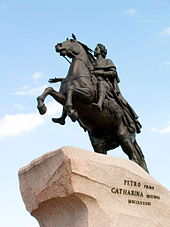 The St. Petersburg sightseeing tour includes a lot of interesting places; you'll see a lot of attractions. For example:
The St. Petersburg sightseeing tour includes a lot of interesting places; you'll see a lot of attractions. For example:
- Nevsky Prospekt - the most famous street of the city
- Kazan Cathedral
- Palace Square with the Winter Palace
- Admiralty
- The Bronze Horseman (Peter the Great)
- Isaac's Square with the St. Isaac's Cathedral and the Tsar Nicholas monument
- Peter and Paul Fortress
- Aurora warship
- Spit of St. Basil Island
- and much more.
Featured Tours
If you want to buy excursion during conference please come to stand of WELT company in the lobby of the hotel "Park in Pribaltiyskaya". Quantity of tickets is limited.
ISIT 2011 has selected the following tours as featured tours for attendees on the following days:
| Day | Tour | Price |
| Monday, August 1: | Rivers and canals – 4 Hours | 720 rur/person |
| Tuesday, August 2: | Peterhof – 5 Hours | 2 080 rur/person |
| Wednesday, August 3: | Peter and Paul Fortress - 3 Hours | 760 rur/person |
| Thursday, August 4: | State Hermitage Museum - 3 Hours | 1 200 rur/person |
| Friday, August 5: | Pushkin (Tsartskoye Selo) – 5 Hours | 1 260 rur/person |
Register for this tour through the Travel Assistance System WELT page.
01.08.2011 from 10:00 – 14:00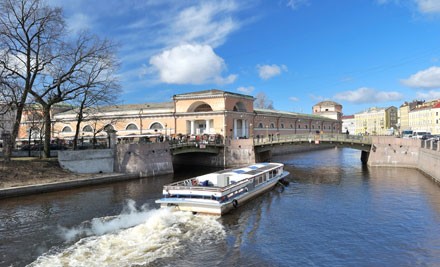
St. Petersburg was built on the delta of the River Neva and is spread out over numerous islands of varying sizes, frequently prompting the nickname the "City of 101 Islands". Over the centuries numerous bridges were built to connect these islands across the various tributaries of the Neva and the city's many canals (Moika, Fontanka, Kanal Griboyedova, etc.).
During the summer months when the river isn't frozen, the bridges across the Neva open at night to allow ships to pass up and down the river. Bridges open from May to late October according to a special schedule. Make sure you check the schedules and don't get caught on the wrong side of the river after 2 a.m.
02.08.2011 from 09:30 – 14:30The world-famous palace, fountain and park ensemble of Peterhof, often called the "Capital of Fountains", is situated 30 km from the center of Saint Petersburg. Without any overestimation Peterhof can be called the main gem of Saint Petersburg's "pearl necklace", as unique suburbs of the city are often called.
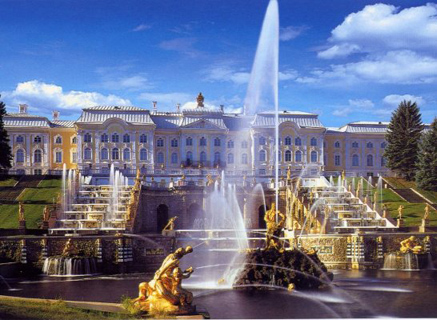
The history of Peterhof dates back to the reign of Peter the Great. The Emperor regularly traveled from Saint Petersburg to Kronshtadt to oversee the construction works. In order he could rest during the long and wearisome trip several wooden houses were built on the place where Peterhof would later appear. In 1714 Peter the Great conceived the creation of a splendid official royal summer residence that would in its splendor overcome French Versal. The Emperor himself took part in the design and construction of the palace - numerous drafts, working drawings with the marks and notes of the tsar have preserved till nowadays witnessing that Peter the Great worked not only on the general layout of the ensemble but created smallest details of the architectural constructions and fountains.
Due to the active interest of Emperor the construction works were carried out at a fast pace. By 1723 Lower Park had been already laid out, the Sea Channel had been dug out, the Monplaisir and the Chateau de Marly had been built, the Upper Chambers had been decorated and the majority of the fountains were functioning. In the same year the solemn ceremony of the gala residence opening were held.
The main attraction of Peterhof is its hundreds of fountains, each unique in style and decor. The most treasured among them is the famous Great Cascade designed by Peter the Great. This grandiose fountain construction unmatched in the world is shaped as a grotto with stairs-waterfalls on the both sides. The Samson Fountain with a great spewing lion became the brightest monument to the glorious victory of the Russians over the Swedes in 1709. Its symbols can be easily interpreted as the lion was depicted on the coats of arm of Sweden and Peter the Great was often compared with Biblical Samson.
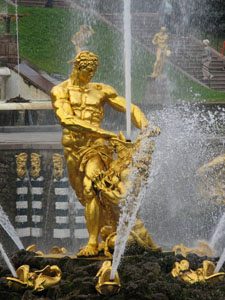
The wonderful parks, countless fountains of various forms and styles, cascades, majestic palaces, numerous gilded statues of ancient gods and heroes were to demonstrate the might and glory of Russia that had turned into a navy state and become firmly established on the Baltic Sea.
World War II became an ordeal for Peterhof. It was occupied for 3 years and during this time the Nazis blasted and burnt the Great Palace, severely damaged the Great Cascade and the cascades of the Gold Hill and the Chess Hill, destroyed the underground systems of water pipes, cut down the trees, dug and mined the parks, took away many statues, the famous Samson among them. Only due to the efforts of hundreds of experts, restorers and artists modern visitors can again admire the unique beauty of Peterhof, that represents the harmony of art and nature. The gleaming gold, the exquisite architecture and the splashing of the fountains create the most impressive sight.
03.08.2011 from 09:30 - 12:30Peter and Paul Fortress laid May 27, 1703. According to legend, Peter I chose a place for the new fortress - a small Rabbit Island (in Finnish - Enisaari), located at the mouth of the Neva River.The Citadel in the form of a six-pointed star was constructed under the project, compiled by a French engineer JG Lambert, with the participation of the king.
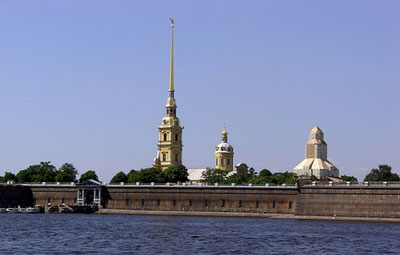
Six curtains combine six powerful bastions, named after the companions of Peter I. Defensive system in the west and east, close the St John and Alekseevskii ravelins. Two bridges - St John and Kronverksky - join Rabbit Island with the Petrograd. October 1, 1703 the fortress was consecrated. At the Czar BastionSt. Andrew's flag was hoisted on the ramparts set three hundred guns. June 29, 1703 in the center of the fortress laid a small wooden church of the apostles Peter and Paul, in the place which in the years 1712-1732 was erected a stone cathedral. From 1731 to 1858 and Paul Cathedral was the status of the cathedral church of the capital, and then was attached to the court department. The cathedral was the burial place of the reigning House of Romanov. Here are buried Russian emperors and empresses from Peter I to Nicolas II, with the exception of Peter II, John VI.From the cathedral covered gallery connected Velikoknyazheskaya tomb.
During the XVIII-XIX centuries on the territory of the fortress were constructed buildings and facilities for various purposes: Botnia house, artillery arsenal, mint, Curfew and Engineering building, a well guardhouse, and others. Already in the XVIII century it became a place of conclusion of the state of criminals, in the XIX - the main political prison in Russia.
When Alexander I at the beginning of the XIX century castle was first opened to visitors. In 1900-ies in the Peter and Paul Cathedral conducted tours of the imperial necropolis. In 1924, the Trubetskoy Bastion prison into a museum.
In 1954, the buildings of the fortress was handed over to the State Museum of History of Leningrad (St. Petersburg).
04.08.2011 from 10:00 - 12:30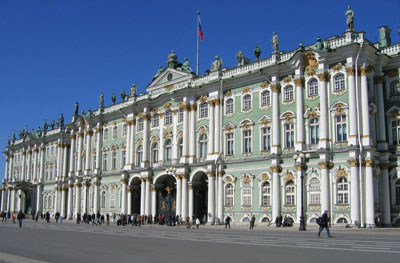
St. Petersburg's most popular visitor attraction, and one of the world's largest and most prestigious museums, the Hermitage is a must-see for all first-time travellers to the city. With over 3 million items in its collection, it also definitely rewards repeat visits, and new-comers can only hope to get a brief taste of the riches on offer here, from Impressionist masterpieces to fascinating Oriental treasures. One estimate has it that you would need eleven years to view each exhibit on display for just one minute, so many visitors prefer to organize a guided tour to ensure they have time to catch all the collection's highlights. Art aficionados, however, may find it more rewarding to seek out for themselves the works that they are particularly interested in.
The bulk of the Hermitage collection is housed in the Winter Palace, formerly the official residence of the Romanov Tsars, and its several annexes. However, there are a number of other sites that constitute part of the Hermitage, including the recently opened Storage Facility in the north of St. Petersburg, which offers guided tours through some of the museum's vast stocks. Our guide to visiting the Hermitage is designed to help you find your way around this enormous collection, with a detailed tour of the main site and individual information on each of the affiliated museums.
05.08.2011 from 09:00 - 14:30The Tsarskoye Selo palace and park ensemble (the State Museum-Preserve Tsarskoye Selo) is a superb monument of world-ranking architecture and garden-and-park design dating from the eighteenth to early twentieth centuries. A whole constellation of outstanding architects, sculptors and painters made the ideas of their crowned clients a reality here. Tsarskoye Selo is a cluster of very fine examples of Baroque and Classical architecture and it was also the first place in the Russian capital where interiors decorated in the Moderne (Art Nouveau) style appeared.
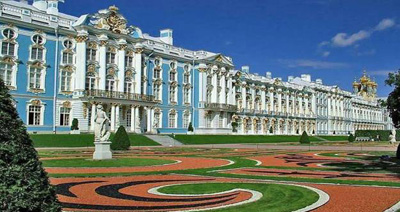
The compositional centre of the ensemble is the Great Tsarskoye Selo or Catherine Palace – a splendid example of the Russian Baroque. Visitors are enraptured by the sumptuous decor of the Great Hall and the Golden Enfilade of state rooms that includes the world-famous Amber Room now returned to life. Today, as we enter the palace, we can sense the spirit of the times of Empresses Elizabeth and Catherine II and admire unique works of fine and applied art.
Tsarskoye Selo is also home to one of the finest creations of Classicism in architecture – the Alexander Palace. Passing through the rooms of the living apartments that are open to visitors, you can get an idea of the aesthetic preferences of the last members of the Romanov dynasty and view the Emperor’s State Study that was decorated in the Moderne style.
More than a hundred historical monuments are scattered across the Catherine and Alexander Parks that have a joint area of 300 hectares: there are grand palaces and intimate pavilions, bridges and marble monuments, and also exotic structures imitating Gothic, Turkish and Chinese architecture that invest little corners of the parks with a romantic atmosphere.
The display of the Catherine Palace (known until 1910 as the Great Palace of Tsarskoye Selo) museum covers the almost 300-year history of this outstanding edifice and presents the work of architects involved in its construction and decoration in the eighteenth and nineteenth centuries and also with the achievements of the restorers who returned the palace to life after the Second World War. Of the 58 halls destroyed during the war years, 32 have been recreated.

































